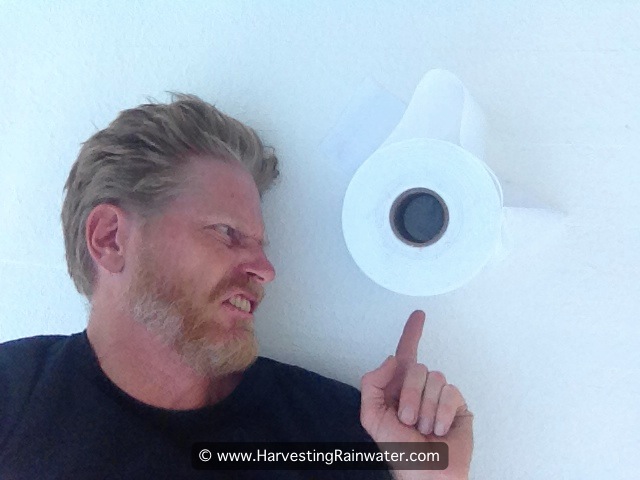Hidden Toxins in Roofing Materials From Which We Harvest Water
by Brad Lancaster © 2014
www.HarvestingRainwater.com
One of the best ways to make sure we have clean water is to avoid polluting our air and the water in the first place. This is why I recommend using only non-toxic building products and, ideally, making sure all materials in a water-collection system are rated for potable-water quality. (This is one of the 10 Cistern-System Principles from my book, Rainwater Harvesting for Drylands and Beyond, Volume 1, 3rd Edition.)

Well, I made an oversight. Most of my roof (from which I collect my drinking water) is 26-gauge corrugated galvalume steel (which I am still happy with), but over my porch roof (on which I like to sometimes sleep and use as a terrace) I used asphalt rolled roofing which I coated with non-toxic elastomeric paint. I felt good about all this until I came upon the discovery that the reinforcing fabric used to cover the seams and prevent cracking in the roof paint between sections of the rolled roofing has the following warning:
CAUTION: MAY CAUSE SKIN IRRITATION
FOR EXTERIOR USE ONLY
Keep Out of Reach of Children
Do not use in drinking water or food systems.
CALIF. PROP. 65 • CHEMICAL WARNING (CALIFORNIA HEALTH AND SAFETY CODE #25249.5 ET SEQ). WARNING: This product contains chemicals known to the State of California to cause cancer, birth defects or reproductive harm. Use proper protection and adequate ventilation when using product.
Note that this warning could not be found anywhere on the product. I did not find it until I searched the product’s website (after having used the product) for the Material Safety Data Sheets and other documents that let me know what is actually in the product and/or uses of the product that are not appropriate. I should have done this before using the product, but I mistakenly assumed it was just benign fabric. Lesson learned—always do the research first and don’t make decisions based on unconfirmed assumptions.
I’ve since emailed the manufacturer of the non-toxic roof paint which I used to coat the roof and fabric to see if they knew of a non-toxic alternative reinforcing fabric. They do not, thus such a product needs to be developed—spread the word.
I am continuing to pursue non-toxic options and will post them on my Roofing page that lists non-toxic options. Options for other materials can be found on my Materials and Suppliers page. Please let me know of others I have missed.
I created these pages and this blog post so you don’t have to reinvent the information wheel, and so you can leapfrog me and my learning curve in the hopes that you’ll enable others to leapfrog you.
As for my roof, I painted extra coats of non-toxic elastomeric roof paint over the reinforcing fabric, and will repaint more often than is recommended by the paint manufacturer. I don’t know if this will keep me free of toxins—it is just my stop-gap solution as I continue to ponder the situation.
If curious, see this video to see more of my system, and…
See the new, full-color, revised editions of Brad’s award-winning books
– available a deep discount, direct from Brad:

Volume 1

